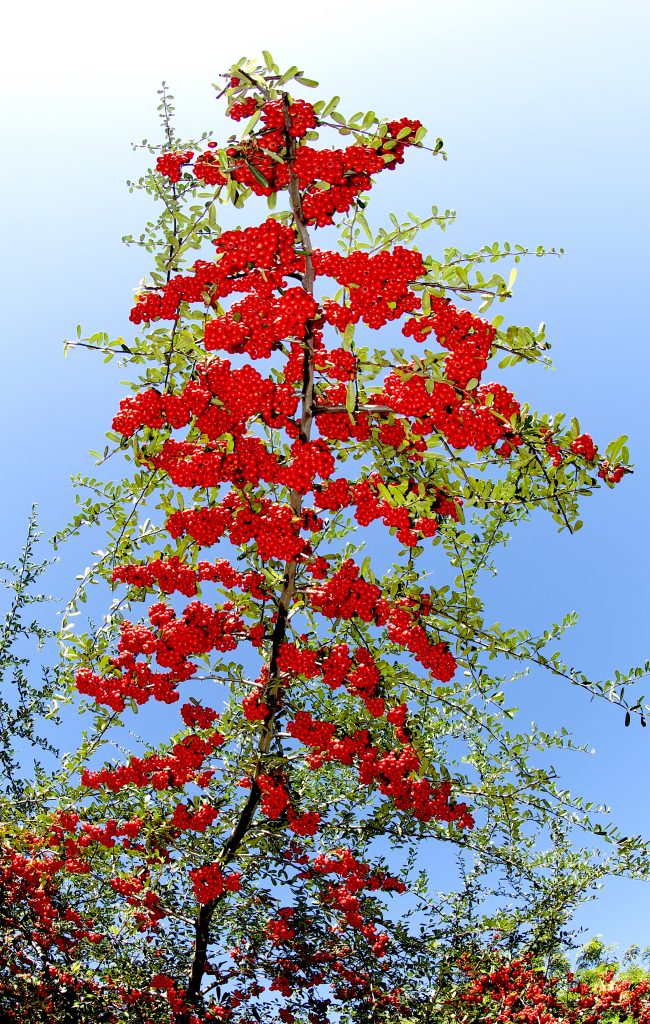
Firethorns are always showy and are also edible but not the seeds. Photo by Green Deane
Pyracanthas are furious in the fall. Their brilliant red berries stand out in every landscape. Like many species in the greater rose family the Pyracantha has a small amount of (glyco-) cyanide in its seeds so they are not eaten. And the pulp of the berry has the texture of an overripe apple with a hint of that pome’s flavor. So they are usually processed into jelly, syrup or even wine. Fortunately we don’t have to remove the seeds before processing the berries. You can cook the berries seeds and all but then you have to strain the seeds out. Also know that while in northern climates the Pyracantha fruit once a year in warmer climates they can fruit twice. To read more about the Pyracantha go here.
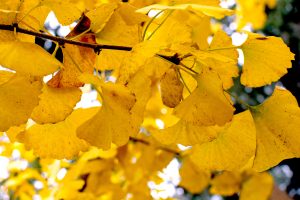
Ginkgo leaves in fall, Savannah Georgia.
Also showy and easy to spot in fall foliage is the Ginkgo tree. This Asian native lives to be thousands of years old so identifying exactly when a tree is mature is a bit iffy. However, they do fruit when fairly young. As you might expect all the Ginkgo trees in North American are on the young side but they start fruiting when they are around 12 to 15 feet high. There used to be one in my neighborhood but was removed because it was too close to a fire hydrant. Perhaps moving the hydrant would have been a better long-term decision as the species tends to outlive successive civilizations. Gingko bark resembles an oak and often has a few holes where the insect-eating birds scrounged for lunch. Historically the first US ship to go to China and back was in 1784-85 thus it is doubtful there are any Ginkgo trees more than 330 years old or so in North America. However, some Ginkgo trees were reportedly planted in Augusta, Georgia as early as 1801-02 in honor of George Washington. To read more about the Ginkgo go here.
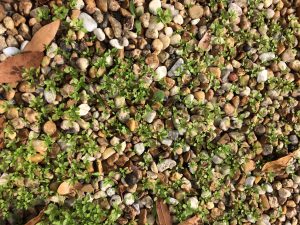
Baby chickweed making its seasonal debut in Jacksonville. Photo by Green Deane
Real chickweed has arrived, barely. I usually find chickweed locally between Christmas and Valentine’s Day. It can be found earlier and occasionally after Valentine’s Day. This past weekend some very young was spotted. It was the real deal because it tastes like raw corn. Those two holidays mark the practical beginning and end of the local chickweed season. It also doesn’t grow much farther south than central Florida. In northern climates Chickweed is a green of spring. It actually germinates under the snow so it can get a head start on other spring plants. Snow spits here every half century or so and the ground never freezes which is why we can forage 365 days a year. Chickweed is fairly easy to identify. Besides tasting like corn silk it has a stretchy inner core and one line of hair that runs along the stem switching sides at each pair of leaves. Don’t confuse Chickweed for a local cousin the edible, Drymaria cordata. To read more about chickweed click here. Also coming on strong is Pellitory. To read about Pellitory again click here.
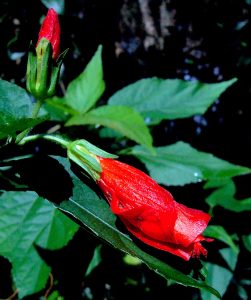
These hibiscus blossoms never open. Photo by Green Deane
Although it is getting cooler… much cooler…. you can still see Hibiscus blooming mid-state including the “Sleepy Hibiscus.” It’s a fairly easy shrub to identify because the bright red blossoms never unfurl. They are sweet and usually come stocked with a few bugs inside. They also color herbal teas nicely. Some folks also cook and eat young leaves.
On the southern end of the state Bauhinia are also blossoming. It’s a tree that is both easy and challenging at the same time. The blossoms are edible, look nice in salads. Some of the species have edible seeds and some do not. (They are in the pea family and most pea trees — most not all — do not have edible seeds.) Sorting out which Bauhinia you have can be a challenge, nearly as bad as sorting out which Cereus you have. Like the Cereus cactus there are several man-made Bauhinia hybrids and perhaps some fake botanical names. It can make species identification a real headache though as far as I know all the blossoms are edible. Only “discovered” about a century ago the blossom of the Bauhinia blakeana is the emblem of Hong Kong. You can read about the Bauhinia here.
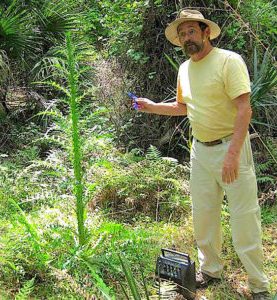
Foraging classes are held rain or shine, heat or cold.
Foraging Classes December: Saturday’s foraging class is at an alternative location in the greater Orlando area, Sanlando Park in Altamonte Springs. It’s smaller than other area and it is winter so we’ll have to scrounge a bit but there are plenty of wild edibles to be found. Sunday’s class is along the Peace River in Port Charlotte.
Saturday, December 15th, Seminole Wekiva Trail, Sanlando Park, 401 West Highland St. Altamonte Springs, Florida 32714. 9 a.m. to noon. Meet in the parking lot, first right after entering the park.
Sunday, December 16, Bayshore Live Oak Park, Bayshore Drive. Port Charlotte. 9 a.m to noon, meet at the park across from Ganyard Street.
Saturday, December 22nd, Dreher Park, 1200 Southern Blvd., West Palm Beach, 33405. Nine a.m. to noon. Meet just north of the science center.
Sunday, December 23rd, Blanchard Park, 10501 Jay Blanchard Trail, Orlando, FL 32817. 9 a.m. to noon, meet at the tennis courts next to YMCA building.
Saturday, December 29th, Jervey Gantt Recreation Complex, 2390 SE 36th Ave., Ocala, FL, 34471. 9 a.m. to noon. Meet in the parking lot north of the water complex.
For more information on foraging classes go here.
Most of us have been told eating apple seeds is dangerous. That is usually followed by “there was a man who ate a cup of apple seeds and died…”
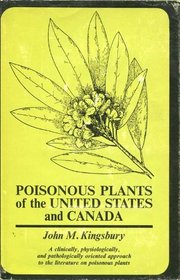 Is that theoretically possible? Yes. You’d have to eat 85 grams of apples seeds, about three ounces, or about 114 seeds, all at one time, all thoroughly chewed. That could, in theory, deliver a fatal dose of cyanide. That’s for a 150 pound person, a larger person could tolerate more, a child much less. Probably children should not eat any apple seeds. The way cyanide works is rather fascinating. It attaches to our red blood cells better than oxygen. So instead of oxygen being delivered throughout the body for use cyanide is. We essentially suffocate. But what about the guy who ate the cup of seeds? There’s bit of a problem with that. In 1964 John Kingsbury, PhD., an expert on plant poisonings particularly regarding farm animals, published Poisonous Plants of the United States and Canada, Prentice-Hall. He was the expert and his book became the book to reference. On page 365 Kingsbury wrote:
Is that theoretically possible? Yes. You’d have to eat 85 grams of apples seeds, about three ounces, or about 114 seeds, all at one time, all thoroughly chewed. That could, in theory, deliver a fatal dose of cyanide. That’s for a 150 pound person, a larger person could tolerate more, a child much less. Probably children should not eat any apple seeds. The way cyanide works is rather fascinating. It attaches to our red blood cells better than oxygen. So instead of oxygen being delivered throughout the body for use cyanide is. We essentially suffocate. But what about the guy who ate the cup of seeds? There’s bit of a problem with that. In 1964 John Kingsbury, PhD., an expert on plant poisonings particularly regarding farm animals, published Poisonous Plants of the United States and Canada, Prentice-Hall. He was the expert and his book became the book to reference. On page 365 Kingsbury wrote:
“Apple seeds are cyanogenetic. A man, who found apple seeds a delicacy, saved a cupful of them. Eating them at one time, he was killed by cyanide poisoning.”
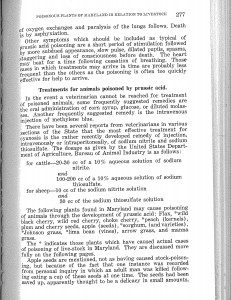 Professor Kingsbury’s inclusion of the incident in his book gave the story legitimacy and it’s been quoted extensively ever since by professionals and amateurs alike. But from a journalistic point of view the story is full of what we used to call in the newsroom “holes.” Who ate the seeds, when, and where? Basic facts that add credibility. Professor that he was Kingsbury included where he got the story from in footnote 1335. That footnote reads: Reynard, G.B., and J.B.S. Norton in Poisonous Plants of Maryland in Relationship to Livestock. Maryland Agricultural Experimental Station, Technical Bulletin. A10, 1942. 312pp. So Kingsbury in 1964 is quoting a farm bulletin from 1942. What does that bulletin say? On page 276 of the now 76-year old bulletin Reynard and Norton write about prussic acid harming livestock. (Amygdalin is essentially a sugar and cyanide molecule which when digested releases hydrogen cyanide which used to be called prussic acid.) They note in the last paragraph: (photo right)
Professor Kingsbury’s inclusion of the incident in his book gave the story legitimacy and it’s been quoted extensively ever since by professionals and amateurs alike. But from a journalistic point of view the story is full of what we used to call in the newsroom “holes.” Who ate the seeds, when, and where? Basic facts that add credibility. Professor that he was Kingsbury included where he got the story from in footnote 1335. That footnote reads: Reynard, G.B., and J.B.S. Norton in Poisonous Plants of Maryland in Relationship to Livestock. Maryland Agricultural Experimental Station, Technical Bulletin. A10, 1942. 312pp. So Kingsbury in 1964 is quoting a farm bulletin from 1942. What does that bulletin say? On page 276 of the now 76-year old bulletin Reynard and Norton write about prussic acid harming livestock. (Amygdalin is essentially a sugar and cyanide molecule which when digested releases hydrogen cyanide which used to be called prussic acid.) They note in the last paragraph: (photo right)
“Apple seeds are mentioned, not as having caused stock-poisoning, but because of the fact that one instance was recorded from personal inquiry in which an adult man was killed following eating a cup of these seeds at one time. The seeds had been saved up, apparently thought to be a delicacy in small amounts and upon being eaten developed enough of the deadly prussic acid to cause this tragic death. The instance is recorded here as a caution to others who might attempt to eat more than a few of these seeds at any one time. Previous investigators have reported that apple seeds contain appreciable amounts of amygdalin from which prussic acid is developed, but actual reports of poisoning are rare.”
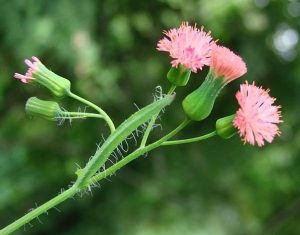
Florida Tasselflower is long-term toxic to humans and very toxic for horses.
Livestock poisonings from prussic acid are “rare.” What of humans? A 130-year search of the New York Times by this writer produced 437 stories involving prussic acid. Those included suicides, murders and a few accidental medicinal deaths: None by an apple seed overdose. We are left with no who, no where, and no when as well as a “recorded from personal inquiry…” and “apparently.” Very iffy: Read someone told them it had happened. Their reference is as weak as Kingsbury’s. Without a name, a time and place it is not much better than an urban legend. It could have happened, or it just might be an illustrative story. More so, man has been eating apples for some 6,000 years. One would have thought in that amount of time it would have become common knowledge that you don’t eat a lot of apple seeds in one sitting. Also during the days of Johnny Appleseed everyone was making cider and there were millions of seeds available annually for decades if not centuries. One wouldn’t have to save them up at all. Getting rid of apple seeds was a problem, not getting enough of them. Also they dry out very quickly so if you saved only a few at at time by the time you had a cup that way the earlier seeds would not be edible. And with all those millions of seeds around and hungry people why only one report of an apple seed over dose?
We can’t say the story is not true, but we can call it doubtful. That said my mother always ate what seeds she found in an apple. She called them “pips.” She ate them because her mother ate them and if there were no “pips”she was disappointed. She also ate the core. The entire apple was eaten, stem and all. Nothing tossed away. Click here to read about Wild Apples.

Green Deane Forum
Want to identify a plant? Looking for a foraging reference? Do you have a UFO, an Unidentified Flowering Object you want identified? On the Green Deane Forum we chat about foraging all year. And it’s not just about warm-weather plants or just North American flora. Many nations around the world share common weeds so there’s a lot to talk about. There’s also more than weeds. The reference section has information for foraging around the world. There are also articles on food preservation, and forgotten skills from making bows to fermenting food. One special section is “From the Frightening Mail Bag” where we learn from people who eat first then ask questions later. You can join the forum by clicking on “forum” in the menu.
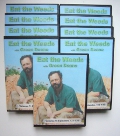
Green Deane DVD set of 135 videos
All of Green Deane’s videos available for free on You Tube. They do have ads on them so every time you watch a Green Deane video I get a quarter of one cent. Four views, one cent. Not exactly a large money-maker but it helps pays for this newsletter. If you want to see the videos without ads and some in slightly better quality you can order the DVD set. It is nine DVDs with 15 videos on each for a total of 135 videos. Many people want their own copy of the videos or they have a slow service and its easier to order then to watch them on-line. The DVDs make a good gift for that forager you know especially on long, cold winter months. Individual DVDs can also be ordered or you can pick and choose. You can order them by clicking on the button on the top right hand side of this page (if your window is open wide enough.) Or you can go here.
 Donations to upgrade EatTheWeeds.com and fund a book have gone well. Thank you to all who have contributed to either via the Go Fund Me link, the PayPal donation link or by writing to Green Deane POB 941793 Maitland FL, 32794. There are many needs left such as expanding the foraging teacher page and the page on monotypic edibles. Several functions were also lost when we transitioned to the new website. I’m still having a hard time finding articles I wrote! There’s always something and such things get more complex and expensive every year.
Donations to upgrade EatTheWeeds.com and fund a book have gone well. Thank you to all who have contributed to either via the Go Fund Me link, the PayPal donation link or by writing to Green Deane POB 941793 Maitland FL, 32794. There are many needs left such as expanding the foraging teacher page and the page on monotypic edibles. Several functions were also lost when we transitioned to the new website. I’m still having a hard time finding articles I wrote! There’s always something and such things get more complex and expensive every year.
This is weekly issue 334. And as a reader of the newsletter mark Dec. 21 for my annual Urban Crawl (my 7th I think.)
If you would like to donate to Eat The Weeds please click here. Or you can use my Go Fund Me link, or by writing to Green Deane POB 941793 Maitland FL, 32794
There are at least five edible species in this photo. Can you find them?
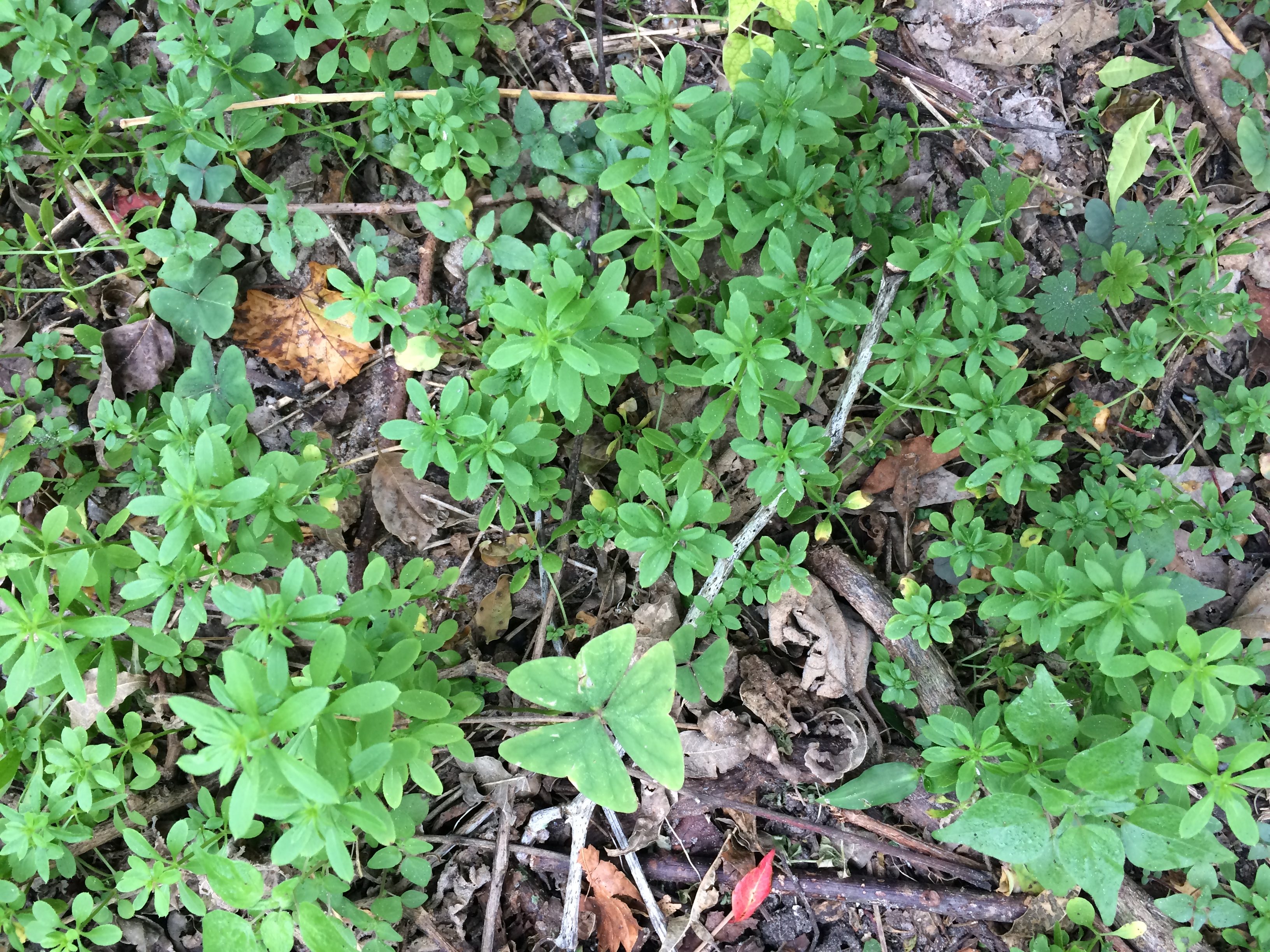


Your comment about Ginko being on the young side in North America makes me wonder about the life of the tree. I’m from St. Louis originally. Being French and over 250 years old, we have many “Squares” – parks every few blocks. In them are some Ginko that must be at least 200 years old. There is a love-hate relationship with them. We love them all year long until they start dropping fruit. Then we hate them.
Here in Kafouri area,Khartoum North,Sudan,I found two blossoming plants both of them give edible fruits used by anaemic people .One has vernacular name ” Hummaide ” and Latin name Grewia tenas and the other is named ” Hunbuck” and has the Latin name Capparis decidua.